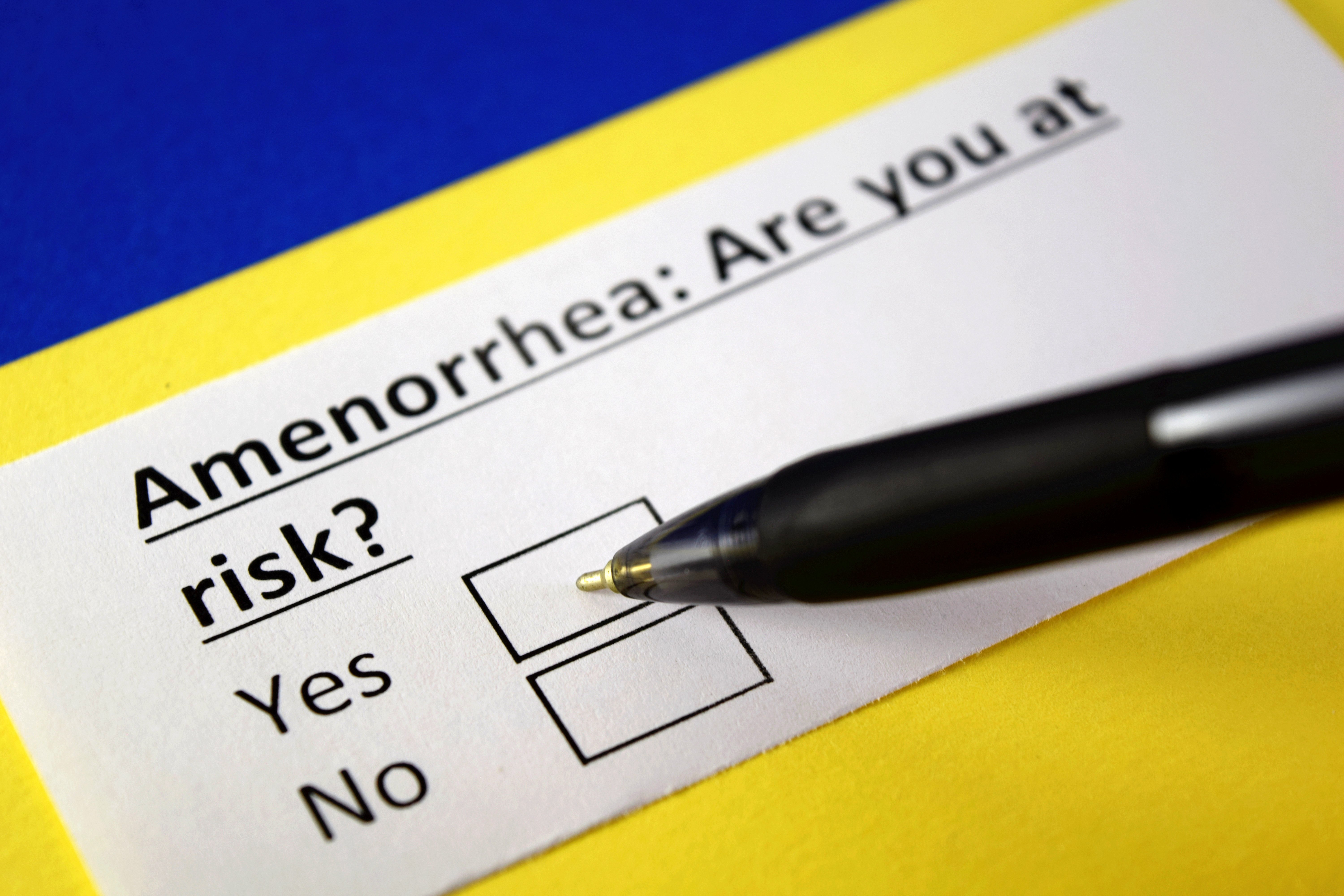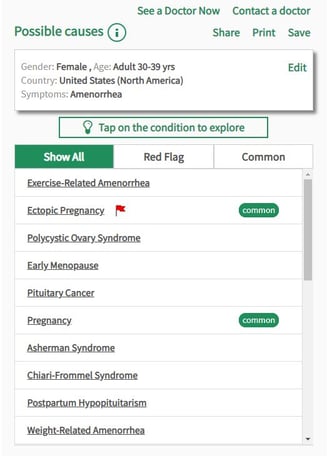- Privacy Policy
- Terms & Conditions
- Contact us
- ©Isabel Healthcare 2025
Amenorrhea (Absent Periods) | 1 Minute Read | Symptom Information
Amenorrhea is the absence of menstruation or monthly periods. It may occur in women before the menarche (before periods have started), after the menopause, during pregnancy or after an operation like a hysterectomy. There are two types of this condition: Primary and Secondary.

Primary amenorrhea occurs in less than 1% of the population and is when menses (monthly periods) haven’t occurred by the age of 15-16 years. If other secondary sexual characteristics such as development of breasts or growth of pubic hair are also absent by age 14 years then a Doctor should be consulted. If these other characteristics have developed but the monthly periods haven’t commenced then it may be advisable to wait until aged 15 years before consulting a Doctor.
Secondary amenorrhea is when menstruation has started but has unexpectedly been missed for at least three periods in a row and this occurs in 3-5% of the population. Pregnancy is by far the most common cause of secondary amenorrhea and should also be considered in teenagers who are experiencing primary amenorrhea. Other causes of amenorrhea include problems associated with the reproductive system or with glands that regulate hormones (in the endocrine system). Once the cause of the amenorrhea is diagnosed and treated then the amenorrhea is normally resolved.
Causes of Amenorrhea
In the case of a 30-39 year old woman experiencing amenorrhea the following problems should be considered in partnership with your medical professional to decide on what the cause of action should be.

Amenorrhea possible causes – Isabel Symptom Checker
Pregnancy
This is the most common cause of amenorrhea and can be easily overlooked, as females haven’t considered that they could possibly be pregnant. You can still become pregnant even if you do not have regular periods. Also, some medical treatments used to treat amenorrhea can increase the chances of pregnancy. It you do not want to become pregnant and have been diagnosed with amenorrhea ensure you use contraception to prevent pregnancy. It is also worth noting that women who are breastfeeding, even if periods have not yet returned post having a baby, have the potential to become pregnant, so contraception should be used if you do not want to take the risk.
Polycystic Ovarian Syndrome (PCOS)
This means that a woman’s hormones are out of balance. It can cause ovarian cysts and also irregular periods or missed periods plus other symptoms like acne, weight gain, thinning hair (alopecia) and depression. If left untreated and not diagnosed it can also lead to diabetes and heart disease.
Pelvic Inflammatory disease (PID)
This is an infection of the reproductive organs in women. Several types of bacteria can cause PID including those of a sexually transmitted nature like Gonorrhea or Chlamydia. The bacteria normally enter the vagina and if left untreated can spread around the reproductive system, causing the infection to spread and symptoms to worsen. Symptoms include abdominal pain, fever, painful sexual intercourse, painful urination, irregular periods and vaginal discharge. As they are caused by bacteria they need to be treated with antibiotics to treat the infection and prevent complications and sepsis arising.
Exercise related amenorrhea
When periods stop due to excessive exercise there is a problem, as the body thinks it has entered starvation state. It isn’t just the amount of exercise but also types of exercise performed that affect periods, especially those associated with low body weight which include ballet or long distance running. This happens as the amount of energy being consumed by the body is not balanced by adequate nutritional intake and the body begins to shut down organs which are not essential for survival. The reproductive system therefore stops menstrual periods as there is not enough energy available to support a pregnancy.
Even in female athletes who train hard and eat plenty, amenorrhea is common. This is due to the release of stress hormones that lead to feeling so good after exercise - the body’s normal response to exercise. This release of stress hormones interferes with the reproductive hormones necessary to keep the menstrual cycle regular and flowing. A diagnosis of exercise related amenorrhea is a diagnosis of exclusion; only when the woman has been resolved for other causes of amenorrhea listed above should this be considered as a diagnosis.
Asherman syndrome
Asherman syndrome is caused by the formation of scar tissue in the uterine cavity. This can occur after several dilation and curettage procedures, where endometrial tissue is taken from the uterus by a health professional to test the tissue. A severe pelvic infection can also lead to Asherman syndrome. Symptoms include amenorrhea, repeated miscarriages and infertility.
Pituitary cancer
This is a rare cause of amenorrhea but if there are very high levels of prolactin in the blood (hyperprolactinemia) then this could be a potential cause. It should be remembered that Hyperprolactinemia can also be caused by hypothyroidism and some medications like Phenothiazines.
Risk factors:
There are certain factors which may increase your risk of amenorrhea which include:
-
Family history – If other females in your family have had amenorrhea in the past then you may have an increased chance of experiencing amenorrhea.
-
Eating disorder – If you have an eating disorder like Anorexia or Bulimia nervosa then you have a higher risk of developing amenorrhea.
-
Rigorous sports – If you have low body weight and are expending more energy through exercise than food you are taking in on a prolonged basis then you have a higher risk of developing amenorrhea.
Complications of Amenorrhea:
-
Infertility – If you don’t ovulate and have periods then you cannot become pregnant.
-
Osteoporosis – If your amenorrhea is caused by low estrogen which isn’t treated then you have an increased risk of developing osteoporosis which weakens your bones.
How you can help your doctor:
Before your consultation with you doctor, think about the following questions they may ask you.
-
When was your last period?
Keep a menstrual diary, documenting your menstruation cycle, how long a period is, how frequently or infrequently your periods occur, what the color of the menstrual bleeding is and how thin or thick it is. Remember to also document any spotting or vaginal discharge you get in between periods.
-
Are you sexually active or could you be pregnant?
-
Do you use contraception/birth control?
-
Are you suffering from any stress?
-
How often and what type of exercise do you do?
-
Do you have any other medical conditions?
-
What medications are you taking?
When is Amenorrhea an emergency?
If a person who has amenorrhea develops a high fever and abdominal pain, they should be seen by a medical practitioner urgently to ensure they do not have a pelvic infection and to rule out pregnancy or ectopic pregnancy. For all concerns regarding amenorrhea you should contact your medical practitioner.
Run your symptoms through the Isabel Symptom Checker, download our app for apple and android:

Mandy Tomlinson
Mandy has worked for Isabel Healthcare since 2000. Prior to this, she was a Senior Staff Nurse on the Pediatric Infectious disease ward and high dependency unit at one of London's top hospitals, St Mary’s in Paddington which is part of Imperial College Healthcare NHS Trust. Her experience in the healthcare industry for the past 33 years in both the UK and USA means she's a vital resource for our organization. Mandy currently lives and works in Scottsdale, Arizona.
Subscribe Here!
Recent Posts
Isabel DDx Companion with ChatGPT Integration - to help you diagnose even faster
At Isabel Healthcare, we’ve always been driven by one goal: to make clinical reasoning faster,..Virtual Triage: Do more questions lead to better patient outcomes?
One of the common misconceptions related to virtual triage / symptom checker tools is that the more..List Of Categories
- Differential Diagnosis Decision Support
- Differential diagnosis
- Symptom Checker
- Symptoms
- Medical Error
- Patient Disease Information
- Disease
- Clinical Decision Support
- Diagnostic Decision Support
- Isabel 1 Minute Read
- Diagnosis Error
- Diagnosis Skills Cases
- Healthcare Informatics
- Clinical Reasoning
- Evidence-based Medicine
- Medical Education
- Patient Engagement
- Symptom Triage
- Nurse Practitioner Education
- Nursing Decision Support
- Partnership
- Public Health
- COVID-19
- EHR
- Patient Empowerment
- Patient Safety
- rare disease

Start your FREE Trial today
Try the Isabel Pro DDx generator for 30-days - no payment card details required.




